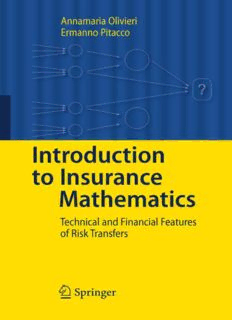Table Of ContentIntroduction to Insurance Mathematics
·
Annamaria Olivieri Ermanno Pitacco
Introduction to
Insurance Mathematics
Technical and Financial Features
of Risk Transfers
123
AnnamariaOlivieri ErmannoPitacco
Universita`diParma Universita`diTrieste
DipartimentodiEconomia DipartimentodiScienze
viaKennedy6 Economiche,Aziendali,
43125Parma MatematicheeStatistiche
Italy piazzaleEuropa1
[email protected] 34127Trieste
Italy
[email protected]
ISBN978-3-642-16028-8 e-ISBN978-3-642-16029-5
DOI10.1007/978-3-642-16029-5
SpringerHeidelbergDordrechtLondonNewYork
LibraryofCongressControlNumber:2010938965
MathematicsSubjectClassification(2010):91B30
(cid:2)c Springer-VerlagBerlinHeidelberg2011
Thisworkissubjecttocopyright.Allrightsarereserved,whetherthewholeorpartofthematerialis
concerned,specificallytherightsoftranslation,reprinting,reuseofillustrations,recitation,broadcasting,
reproductiononmicrofilmorinanyotherway,andstorageindatabanks.Duplicationofthispublication
orpartsthereofispermittedonlyundertheprovisionsoftheGermanCopyrightLawofSeptember9,
1965,initscurrentversion,andpermissionforusemustalwaysbeobtainedfromSpringer.Violations
areliabletoprosecutionundertheGermanCopyrightLaw.
Theuseofgeneraldescriptivenames,registerednames,trademarks,etc.inthispublicationdoesnot
imply,evenintheabsenceofaspecificstatement,thatsuchnamesareexemptfromtherelevantprotective
lawsandregulationsandthereforefreeforgeneraluse.
Coverdesign:WMXDesignGmbH,Heidelberg
Printedonacid-freepaper
SpringerispartofSpringerScience+BusinessMedia(www.springer.com)
Preface
Thisbookaimsatintroducingtechnicalandfinancialaspectsoftheinsurancebusi-
ness, with a special emphasis on the actuarial valuation of insurance products.
While most of the presentation concerns life insurance, also non-life insurance is
addressed,aswellaspensionplans.
Thebookhasbeenplannedassumingastargetreaders:
• advanced undergraduate and graduate students in Economics, Business and Fi-
nance;
• advancedundergraduatestudentsinMathematicsandStatistics,possiblyaiming
atattending,aftergraduation,actuarialcoursesatamasterlevel;
• professionals and technicians operating in insurance and pension areas, whose
job may regard investments, risk analysis, financial reporting, and so on, hence
implyingcommunicationwithactuarialprofessionalsandmanagers.
Given the assumed target, the use of complex mathematical tools has been
avoided.Inthissense,thebookcanbeplacedatsome“midpoint”oftheexistinglit-
erature,partofwhichadoptsmoreformalapproachestoinsuranceproblems,which
impliestheuseofnon-elementarymathematicsandcalculus,whereasanotherpart
addressespracticalquestionstotallyavoidingevenbasicmathematics(which,inour
opinion,canconverselyprovideeffectivetoolsforpresentingtechnicalandfinancial
featuresoftheinsurancebusiness).
WeassumethatthereaderhasattendedcoursesprovidingbasicnotionsofFinan-
cialMathematics(interestrates,compoundinterest,presentvalues,accumulations,
annuities,etc.)andProbability(probabilitydistributions,conditionalprobabilities,
expectedvalue,variance,etc).Asmentioned,Mathematicshasbeenkeptatarather
lowlevel.Indeed,almostalltopicsarepresentedina“discrete”framework,thusnot
requiring analytical tools like differentials, integrals, etc. Some Sections in which
differentialcalculushasbeenusedcanbeskipped,withoutsignificantlossesinun-
derstandingthefollowingmaterial.
Somedetailsconcerningthechaptersofthebookcanhelpinexplainingthe“ra-
tionale”underlyingitsstructureandthechoiceofthematerialsthereinincluded.
v
vi Preface
Chapter1firstaimsatpresentingtheconceptofrisk,focussinginparticularon
the(negative)consequencesofsomeeventswhichcanconcernaperson,afamily,a
firm,andsoon.Secondly,theChapterdescribestheroleofaninsurancecompany,
which takes individual risks,buildsupapool of risks,and bears theriskoflosses
caused by large numbers of events within the pool or unexpected severity of the
claims.
InChapter2variousaspectsoftheriskpoolingprocessareaddressed.Theeffects
ofcross-subsidy(and,inparticular,mutualityandsolidarity)areillustrated.Then,
referring to a simple portfolio structure, reinsurance arrangements, solvency and
capitalallocationaredealtwith.
Hence,thefirsttwoChaptersprovidethereaderwithanintroductiontoriskand
insurance. Indeed, a risk-management oriented approach should underpin, in our
opinion, the teaching of the insurance technique and finance. It is worth stressing
that these two Chapters can fulfill the syllabus of a very short course (say, 20-25
hours) aiming to present the basics of riskidentification, riskassessment, and risk
managementactions.
Chapters 3 to 7 focus on life insurance. Although many topics dealt with are
rathertraditional(lifetables,discountingcash-flows,premiumsandreservesforvar-
iousinsuranceproducts),severalissuesofgreatcurrentinteresthavebeenincluded;
for example: mortality trends, best-estimate reserving, risk margins, profit assess-
ment, linking life insurance benefits to the investment performance, unit-linked
products,andsoon.
Chapter8addressesproblemsrelatedtothepost-retirementincome.Inparticular,
definedcontributionpensionplansareaddressed.Theprotectionthatanindividual
canobtainbyunderwritingappropriatebenefitsandfinancialguarantees,beforeand
after retirement, is examined. Special emphasis is placed on life annuities as an
element in post-retirement income arrangements. Risks emerging for the provider
aredescribed,withparticularregardtothefinancialandlongevityrisks.
Finally, Chapter 9 deals with non-life insurance. First, an overview of the con-
tents of non-life insurance products is provided. Then, premium calculation and
relatedstatisticalbasesarefocused.IssuespresentedinChapter1areprogressed,in
ordertointroducethestochasticmodelingofclaimfrequency,claimseverityandag-
gregateclaimamounts.Anintroductiontotechnicalreservesandprofitassessment
concludestheChapter.
Each chapter concludes with a section providing bibliographic references and
suggestions for further reading. The list of references only includes textbooks and
monographs,whiledisregardingpapersinscientificjournals,congressproceedings,
researchandtechnicalreports,andsoon.Ourchoiceaimsatlimitingthenumberof
citations,inlinewiththeteachingorientationofthiswork.
Wehavesuccessfullytestedthelogicalstructureandthecontentsofthebookin
variousrecentcourses.Inparticular:acourseofInsurancetechniqueandfinancefor
graduatestudentsinFinanceattheUniversityofParma;acourseofLifeinsurance
mathematicsforundergraduatestudentsinStatisticsandundergraduatestudentsin
Mathematics at the University of Trieste; courses of Risk and Insurance, Life in-
surance technique, Non-life insurance technique and a distance-learning course of
Preface vii
Insurance technique for employees of a European insurance company, at the MIB
School of Management in Trieste. Part of the material included in the book has
beenusedalsoinCPD(ContinuingProfessionalDevelopment)coursesofLifein-
surance technique for non-actuaries organized by the Italian actuarial professional
body.Further,somespecifictopicshavebeendeliveredinshortseminarsandother
teachinginitiatives(forexample:risk-managementapproachtoinsuranceproblems,
stochastic mortality, linking life insurance benefits to the investment performance,
etc).
Risksmustbecarefullyidentified,assessedandmanagedbyalltheagents(indi-
viduals,households,firms,publicinstitutions,andsoon).Risktransferconstitutes
aneffectivetoolformanagingrisks,andtheimportanceofinsurersinthistransfer
processisself-evident.Actually,theinsurancebusinessconstitutesagrowingmar-
ket.Appropriateriskmanagementsolutionsmustbetakenalsobyinsurers,dueto
theriskstheyassumethroughtheirproducts.
Ifthisbookhelpstobetterunderstandthetechnicalandfinancialfeaturesofthe
insuranceactivity,theroleofinsurersasintermediariesintheriskpoolingprocess
andasfinancialintermediaries,andthebasicsoftheriskmanagementofaninsur-
ancebusiness,thenwehaveachievedourobjective.
AnnamariaOlivieri
Trieste,July2010 ErmannoPitacco
Contents
1 Risksandinsurance ............................................ 1
1.1 Introduction ............................................... 1
1.2 “Risk”:lookingfordefinitions................................ 1
1.2.1 Somepreliminaryideas ............................... 1
1.2.2 Transactionswithrandomresults ....................... 2
1.2.3 Averybasicinsurablerisk ............................ 4
1.2.4 Randomnumberofeventsandrandomamounts .......... 4
1.2.5 Risksinherentintheindividuallifetime ................. 9
1.3 Managingrisks ............................................ 14
1.3.1 Generalaspects...................................... 14
1.3.2 Riskidentificationandriskassessment .................. 15
1.3.3 Riskmanagementactions ............................. 16
1.3.4 Self-insuranceversusinsurance ........................ 18
1.3.5 MonitoringandtheRiskManagementcycle.............. 21
1.4 Quantifyingrisks:somemodels .............................. 21
1.4.1 Somepreliminaryideas ............................... 21
1.4.2 Averybasicmodel................................... 22
1.4.3 Randomnumberofeventsandrandomamounts .......... 23
1.4.4 Randomsums:acriticalassumption .................... 28
1.4.5 Introducingtimeintovaluations........................ 29
1.4.6 Comparingrandomyields ............................. 31
1.4.7 Risk-adjustedvaluations .............................. 33
1.5 Riskmeasures ............................................. 37
1.5.1 Somepreliminaryideas ............................... 37
1.5.2 Traditionalriskmeasures.............................. 38
1.5.3 Downsideriskmeasures .............................. 39
1.5.4 Riskmeasuresandcapitalrequirements ................. 40
1.6 Transferringrisks .......................................... 43
1.6.1 Buildingupapool ................................... 43
1.6.2 Financingthepool ................................... 46
1.6.3 Theroleoftheinsurer ................................ 51
ix
Description:The book aims at presenting technical and financial features of life insurance, non-life insurance, pension plans. The book has been planned assuming non-actuarial readers as its “natural” target, namely - advanced undergraduate and graduate students in Economics, Business and Finance; - profess

